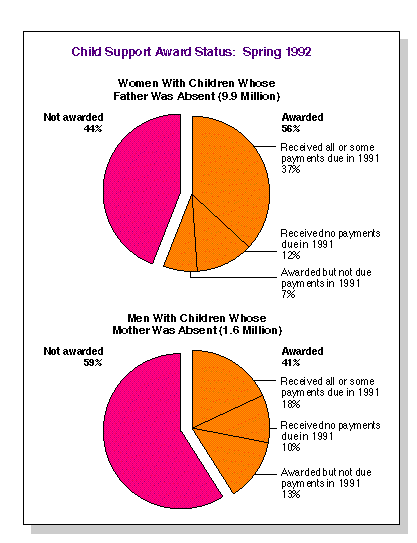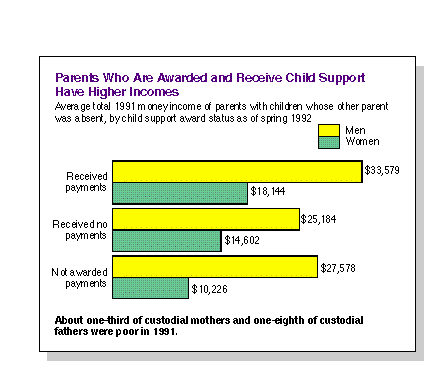

In the past, the Census Bureau has published data only on mothers who receive child support; in this Brief, for the first time, we also present information on fathers who receive it. The April Supplement of the Current Population Survey shows that, in spring 1992, there were 11.5 million persons in the United States who were custodial parents of never-married children under 21 whose other parent was absent from the home. Though most (9.9 million) of these custodial parents were women, a large number (1.6 million) were men. The families they maintained comprised about one-third of families with own, never-married children under 21.
In spring 1992, about one-half (6.2 million) of the 11.5 million custodial parents were awarded child support; award rates were higher for mothers than for fathers (56 percent compared with 41 percent). (See chart, below.)
Fewer than half of the custodial parents (5.3 million, or 46 percent) were supposed to receive child support payments in 1991. Of the 4.9 million women due payments, 76 percent received at least a portion of the amount they were owed. The corresponding rate for the 400,000 men owed money was 63 percent. (See chart below.)
More than 5 million custodial parents were without awards of financial support from their child(ren)'s other parent. About one-third of those without awards had chosen not to pursue them. Two other common reasons they did not have awards were that they did not want an award and that the non-custodial parent was unable to pay.

A total of $11.9 billion was paid in child support in 1991, $5.8 billion less than the amount due. Nearly all of the money paid ($11.2 billion) went to women.
Women who received child support in 1991 were paid an average of $3,011 that year, about one-third more than their male counterparts ($2,292). On average, these support payments constituted 17 percent of 1991 money income for the women, but only 7 percent for the men.
The mothers who received child support had lower average 1991 money income than the fathers who received it ($18,144 compared with $33,579). Income was lower for custodial parents who did not receive payments. (See chart below.)

About 6.9 million of the 11.5 million parents who did not live with their children (non-custodial parents) had joint custody and/or visitation privileges to contact their children. It was more likely for the 5.3 million non-custodial parents who owed child support in 1991 to have made payments if they had one or both of these contact privileges than if they had neither (79 percent compared with 56 percent).
About 4 in 10 parents with child support awards as of 1992 had health insurance benefits included in their award. However, about one-third (31 percent) of the non-custodial parents who were required to provide these benefits in 1991 as part of the award failed to do so. On the other hand, some non-custodial parents (18 percent) not required to provide these benefits as part of the award did so anyway.
An upcoming report, Child Support for Custodial Mothers and Fathers, P60-187, will expand on the information in this Brief. It will be available this summer. Contact Customer Services (301-763-INFO(4636)) then for ordering information.
Contacts:
Child Support -- Lydia Scoon-Rogers or Gordon Lester,
Housing and Household Economics Division
301-763-8576
Statistical Briefs -- Robert Bernstein
301-457-1221
This Brief is one of a series that presents information of current policy interest. It may include data from businesses, households, or other sources. All statistics are subject to sampling variability, as well as survey design flaws, respondent classification errors, and data processing mistakes. The Census Bureau has taken steps to minimize errors, and analytical statements have been tested and meet statistical standards. However, because of methodological differences, use caution when comparing these data with data from other sources.